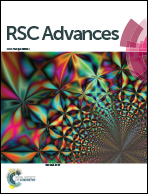Exploration of biological activities of alkyne arms containing Cu(ii) and Ni(ii) complexes: syntheses, crystal structures and DFT calculations†
Abstract
Several mononuclear complexes [Cu(L1), Cu(L2), Ni(L1) and Ni(L2)] containing N,O-donor Schiff base [L1 = 2,2′-{cyclohexane-1,2-diylbis[nitrilo(E)methylylidene]}bis[5-(prop-2-yn-1-yloxy)phenol] and L2 = 2,2′-{1,2-phenylenebis[nitrilo(E)methyllidene]}bis[5-(prop-2-yn-1-yloxy)phenol]] have been synthesized and characterized by elemental analyses and spectral techniques. The solid-state structures of Cu(L1) and Ni(L1) were determined using single-crystal X-ray crystallography reveal distorted square planar geometry around the metal ions. The binding ability of the complexes with DNA and BSA were investigated. DNA cleavage activity reveals that the complexes cleaved the plasmid DNA via hydrolytic path way. In vitro cytotoxicity assays indicate that these complexes exhibit anticancer activity against human cervical carcinoma cell line (HeLa). Flow cytometric analysis and Annexin V/PI double staining assays suggest that these complexes induce cell apoptosis. The comet assay has been employed to find out the extent of DNA fragmentation in cancer cells. The catecholase activity of the complexes has been investigated by UV-vis, cyclic voltammetry and EPR using 3,5-DTBC as model substrate reflect that the complexes are effective in mimicking catecholase like activity. DFT calculation on the mechanistic insights of catalytic activity suggests a ligand-centred radical mechanism.



 Please wait while we load your content...
Please wait while we load your content...